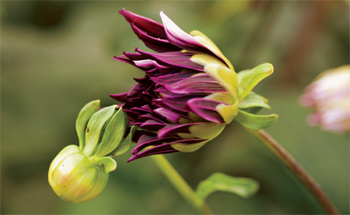
Q. How do I separate and store the Dahlias that I have recently taken out of the ground? I planted one in April and it has multiplied into a clump of twenty to thirty bulbs.
A. Dahlias are actually classified as a tuber and not a bulb. A true bulb contains modified leaves called scales, a basal plate that develops roots and a shoot that emerges from the center. Dahlias lack the basal plate, scales and the roots and the new shoots develop from ‘eyes’ or growth buds. Tulips, Daffodils and Cyclamen are true bulbs, while Dahlias, and Potatoes are examples of tubers. You should first wash the dirt off the clump, exposing all the tubers. If the dirt is already dried, submerge the clump in a bucket of water. After thirty minutes, hose them off and let the clump air-dry. Next, you have two options: divide the clump into individual tubers now and store them or store the entire clump until next year. In April or May, the clump is divided two to four weeks before planting. You’re probably not going to plant all the tubers, so select the largest and firmest, discarding the rest. Each tuber must include a growth bud or ‘eye’. The ‘eyes’ are located along the narrow end of the tuber close to where it attaches to the main or last year’s stalk. With freshly dug Dahlias, the eyes are easy to recognize; otherwise, include a piece or section of last year stalk. All the fresh cuts should be dip in dusting sulfur to prevent rotting. Dahlias are stored in a cool, dry location in an open container in sawdust, sand, vermiculite or perlite. Dividing Dahlias is not as difficult as it might seem. It does have a high success rate.
Q. My cherry trees were traumatized last year with the Black Cherry Aphids. In the past, I controlled Aphids by putting a ring of the sticky stuff around the trunk. This year it didn’t help at all. Will the Lime Sulfur dormant spray keep me Aphid free next year?
A. Two applications of dormant spray, Lime Sulfur and or Oil, are recommended on cherry trees during the winter months. The dormant spray controls the over wintering insects such as scale, mites, and the Aphid eggs. Unfortunately, this dose not guarantees that you will be Aphid free next year. Aphids can over winter on many other woody ornamentals as well as perennials plants. Therefore, I wouldn’t be surprise to see them again. Aphids are not that difficult to control if caught early. You need to monitor the trees in the spring for the first sign of curly leaves. Once they are detected, they are removed and you make three applications of Insecticidal Soap a week apart. This should keep the leaves pristine all season long. I’d still apply the sticky stuff, sold as Tanglefoot or Pest Barrier to the tree trunks. This prevents ants from ferrying the Aphids into the canopy as they feed on the clear sticky residue called ‘Honey Dew’ produced by the Aphids.
Buzz Bertolero is Executive Vice President of Navlet’s Garden Centers and a California Certified Nursery Professional. His web address is www.dirtgardener.com and you can send questions by email at dirtgarden@aol.com or to 360 Civic Drive Ste. ‘D’, Pleasant Hill, Calif. 94523
Virginia,
Sorry it has taken so long to reply. Unfortunately, my other responses kept bouncing back when I used the reply button. Anyway, I have a few questions concerning your plants.
How often are they watered June through October? Do you use sprinklers, drip irrigation or a hose? Is there a sprinkler in front or at the base of each plant? With sprinklers or drip, how long is the watering duration? What is your fertilizer and how often is it applied? Are the plants watered before, after or both before you fertilize?
Is the die back occurring at the top and sides and progressing toward the center, or is it random throughout the plant? Do you mulch? …..Buzz Bertolero
I have two rhododendrons in front of my home that face the morning sun until around 1PM and try to keep them watered regularly. In the last few months the leaves on one of them started turning brown after it bloomed and continue to burn brown. I cut off all the brown leaves and any branches that looked dead. Now that plant is definitely dead and I am going to remove it.
The second plant is large and was beautiful and always did well, but this year it too has branches with brown, dying leaves. I cut off all the brown leaves and trimmed the branches that looked dead and there were quite a few. I fertilized the plant and hope it helps. I hope you can tell me what to do to save it. THANK YOU.